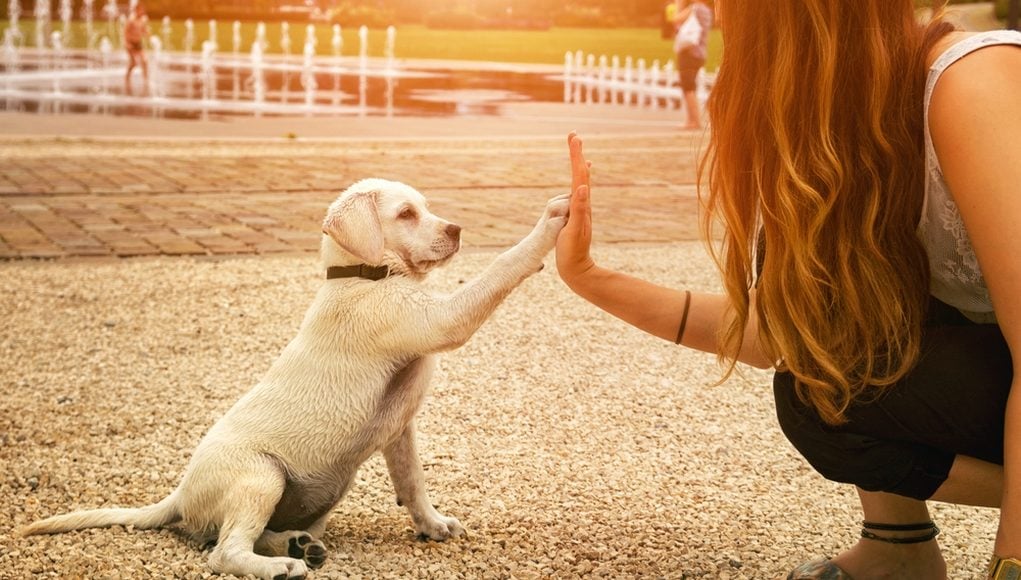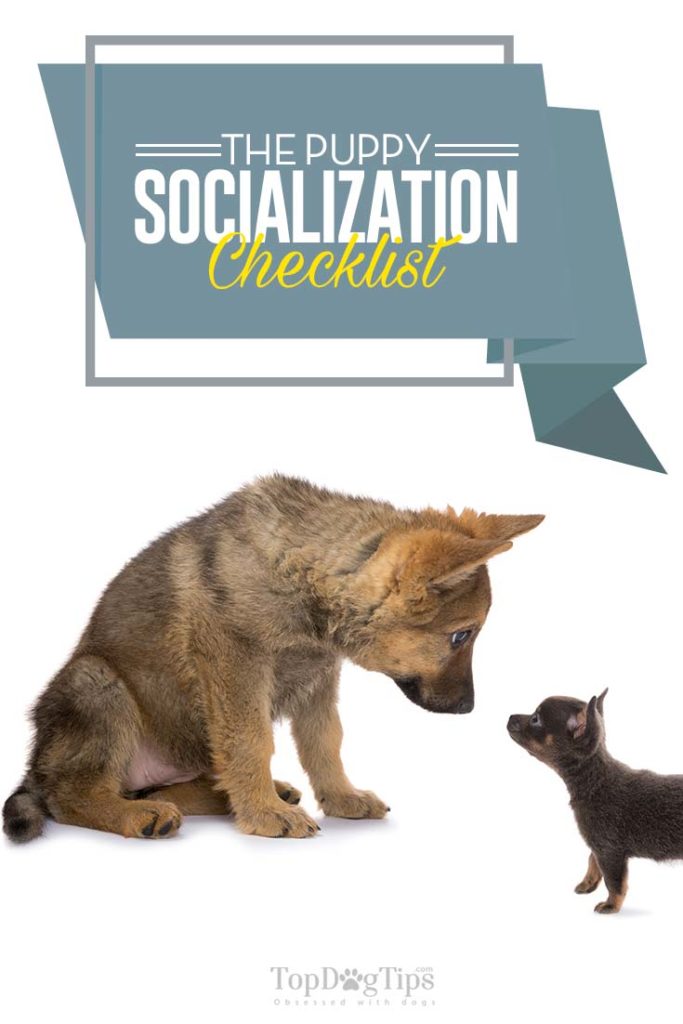To raise a well-adjusted dog, you need ongoing socialization training. Without adequate socialization, the dog may grow up to be fearful or even aggressive. The below puppy socialization checklist will walk you through each step of this training.
Table of Contents
What is Puppy Socialization?
Socialization is simply the process of exposing a puppy to various situations and stimulus to increase the dog's familiarity with them. For example, taking a dog for a walk around the park exposes them to strangers, children, other dogs and wildlife, as well as environmental factors such as wind, sounds and weather.
Socializing a new dog is actually easy but it will take time and patience. Once done, a well-socialized puppy will also adjust better and quicker to any other foreign situation or new stimulus, because they have already been exposed to different things and are familiar with the diversity of the world around them.
On the other hand, an unsocialized puppy is likely to exhibit signs like fear, aggression or shock when confronted with unfamiliar stimuli because they have no concept of diversity. This makes it difficult to have guests in your home or take your puppy with you anywhere. In some instances, it can become even dangerous for the dog or those around them.
Puppy Socialization Checklist
How to Socialize a Puppy?
As noted above, puppy socialization is about exposure to things – sights, sounds, and smells – to desensitize the dog to the unfamiliar. The process should begin with letting your puppy see and experience new stimulus.
During the first introductions, do not overstimulate the puppy. This means a short time of exposure without forced interaction is better than long walks that force the dog into socialization. If a puppy is interested in exploring the situation, allow them to do so.
After a few sessions of exposure, work with your puppy to increase their interaction. If they were previously reluctant to explore the situation, now you can encourage it. You can do this by using dog treats, by taking part in exploration yourself, or tying familiar items to the environment.
Once the puppy is comfortable with minimal interaction, and you've extended the length of each puppy socialization instances, the next step is to increase the level of interaction. Invite more in-depth exploration. For example, ask if people would like to approach your puppy, but remind them that the dog is shy and new to such situations. As the next step, strangers can then talk to the dog, pet and play with them.
When to Begin Socializing Your Puppy?
Socialization for a puppy should begin shortly after birth. Young puppies socialize with their siblings and learn how to interact from their mother. As the puppy grows, they are handled by the owner, breeder or rescue worker to expose them to the human touch.
Many reputable dog breeders and animal rescues also work with young puppies after their vaccinations to safely expose young dogs to other animals or situations. This is done to create a more well-rounded dog that won't grow up to be aggressive towards others.
What You Need to Know About Puppy Socialization
When socializing a puppy, always monitor the dog's body language. If your young dog shows any signs of being uncomfortable during the socialization process, remove them from the situation immediately. Forcing the dog through the puppy socialization checklist steps is likely to achieve the opposite effect and make your pup even more fearful.
Signs that your dog is uncomfortable with a situation and should not be pressed include:
- crouching
- hiding
- urinating
- growling
- whining
- retreating
- baring teeth
- raised hair on the scruff of the neck or back
- tail tucked between the legs
While it’s important to get your puppy used to new places and people, never push them. This process needs to feel natural and done gradually. Forcing a dog into a situation that creates stress for them may even cause biting, snapping, and also lack of trust in you, as well as worsening of existing fear of humans and other animals.
When to Seek Professional Advice?
Most dog owners can socialize puppies themselves without any problems. However, if your puppy shows significant signs of fear or aggression in response to socialization attempts, you may need to call a professional.
Dealing with fearful aggressive dogs not only could result in someone getting hurt, but you could also worsen your dog’s current mental condition. You can find a reputable canine behaviorist or therapist by consulting with your veterinarian.
The Different Types of Socialization for Puppies
If a puppy shows no signs of aggression or fear during the initial steps of socialization, then you can proceed with this by yourself. There are a handful of situations that every dog should be made familiar with at the very beginning: exposure to other dogs, children, strangers, and exposure to new and various situations like parks and dog-friendly stores.
5 Tips on How to Socialize a Puppy
1. Try Puppy Classes
Puppy classes do not have to be the first step on your puppy socialization checklist but they can be extremely helpful if you can afford them. Just remember that you cannot sign your dog up for training classes until he's received all essential vaccinations.
A puppy socialization training class serves many purposes, including:
- your puppy is exposed to other dogs;
- your puppy is introduced to strangers;
- classes are also an opportunity for your puppy to experience groups of people;
- you will bond with your puppy;
- and classes provide your puppy with rules that help him to interact with the world around him.
How do you choose a good puppy class? The best way is to do your research online and consult with a veterinarian or other dog owners who had positive experience. You can find plenty of online reviews from other dog training class members, past and present, as well as any criticisms.
2. Doggy Daycare
Once your puppy has a grasp on basic commands and got their vaccinations, enrolling them in doggy daycare can make the whole socialization part easier. Many recreational doggy day care services exist in every city, and some veterinary clinics offer daycare too.
A dog daycare is exactly what it sounds like (like kindergarten for puppies), and it offers the dog an opportunity to socialize with other dogs of different age and size. This type of dog socialization is important because it prepares your puppy to meet strange animals of various shapes and sizes and to prevent small-dog-phobia or big-dog-phobia.
3. Dog-Friendly Stores
Dog-friendly stores can be beneficial for socializing a puppy because they introduce unique walking surfaces, more strangers, more new dogs, new sounds, new colors and sights, and unique smells.
There are many dog-friendly stores in every city but once again, if your puppy is not up to date on vaccinations or if there is a local epidemic (like canine flu) going on, you should always keep your dog at home. A puppy's immune system is too vulnerable.
4. Children
Exposing your dog to kids while they are young is crucial, and failure to do so can result in a dog that is fearful of children. The best way to introduce a dog to kids is while they are still very young.
Supervised visits with family members' children are a good place to begin. If you do not have children in your family or in your neighborhood, you can expose the dog to children by taking short visits to the park.
Note: no matter where, when or how you introduce a puppy to children, you must always supervise such interactions to keep both your dog and the child safe.
5. Strangers
Your dog should be familiar with the idea of strangers. You can socialize a puppy with strangers by visiting dog-friendly stores, parks, or by simply walking around the neighborhood.
The aim of introducing a dog to strangers is to desensitize them to various types of people. This will decrease the likelihood that your dog will become reactive to unfamiliar types of people in the future and prevent aggression, fear, resource guarding and more.
The Importance of Situational Exposure
It is just as important to expose your dog to different situations and environments as it is to expose them to different people and animals. Dogs that experience little change in scenery or are familiar with only a single environment are easily scared, skittish, and may even become fearfully aggressive.
You can avoid this type of fear by introducing your puppy to many different environments. This step on the puppy socialization checklist should only be done after your dog has received all of their vaccinations, shows no aggression and when the dog is healthy.
Some of the most common places to take a dog to increase their awareness of the world include regular parks, dog parks, pet-friendly stores, your neighborhood, outdoor patios of dog-friendly resorts, drive-thru’s, hiking trails and, of course, the vet’s office.
A Moment Now Saves a Lifetime of Trouble
Socialization for dogs is crucial, because it creates exposure to the world that will always be there as the dog ages. A puppy that receives well-rounded exposure will grow into a well-behaved dog that has a solid blueprint of the world around them.
A dog without socialization, however, will always be fearful, possibly aggressive, and will be in doubt of their surroundings. It is up to you to follow a puppy socialization checklist in order to provide your pooch with the blueprint they will need as an adult dog.
READ NEXT: 10 Best Dog Breeds for First Time Owners















